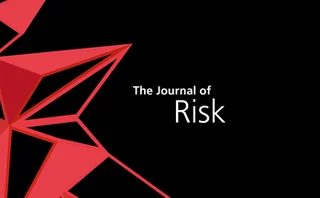Network analysis
Esma pledges faster approvals for CCP margin model changes
Löber says regulatory sign-off on small model changes should take just three weeks under Emir 3.0
A block-structured model for banking networks across multiple countries
This paper develops a block-structured model for the reconstruction of directed and weighted financial networks spanning multiple countries.
The trade-off between liquidity risk and counterparty risk in money market networks
The authors examine how liquidity is exchanged in different types of Colombian money market networks (ie, secured, unsecured and the central bank’s repurchase networks) as registered in the local financial market infrastructure.
A numerical simulation approach to study systemic risk in banking systems
The authors introduce a simple numerical algorithm to study banking systems subject to credit risk. The algorithm is based on a model that is completely defined by only two parameters.
In search of lost edges: a case study on reconstructing financial networks
In this paper, the authors review the different methods designed to estimate matrixes from their marginals and potentially exogenous information.
Structural systemic risk: evolution and main drivers
This paper analyzes how systemic risk structurally evolved between 2007 and 2017. The main contributions of the paper to the literature include the methodology, analysis and potential use for macroprudential policies.
Network sensitivity of systemic risk
Here, we address the more general problem of how shock propagation dynamics depend on the topological details of the underlying network. To this end, we consider different realistic network topologies, all consistent with balance sheet information…
Volatility spillover along the supply chains: a network analysis on economic links
The analysis in this paper reveals that additional fundamental risk gets transferred along supply chains, and that suppliers are exposed to additional fundamental risk that is not captured by their market beta. Suppliers are therefore exposed to…
Quants pitch in to improve pandemic models
The finance industry’s quants are trying their hand at modelling the virus and its economic impact
The impact of the cross-shareholding network on extreme price movements: evidence from China
By using information about the ownership structure of listed companies from 2004 to 2016, the authors construct the cross-shareholding network for each year and examine the effects of the network position of a firm on extreme price movement.
Measuring the systemic risk of China’s banking sector: an application of differential DebtRank
This paper investigates the systemic risk of China’s banking sector via network analysis and differential DebtRank from 2007 to 2016.
Default cascades and systemic risk on different interbank network topologies
This paper examines the relationship between the topology of interbank networks and their ability to propagate localized, idiosyncratic shocks across the banking sector via banks’ interbank claims on one another.
Fire sales turn a crash into a crisis, simulation shows
‘More realistic’ core-periphery model leads to wipeout of network if several nodal banks default
Don’t fear the clearer
Wider use of CCPs not systemic threat – but participants do face hard-to-measure risks
Computational analysis of structural properties of economic and financial networks
This paper surveys the use of networks and network-based methods to study economy- related questions.
News-sentiment networks as a company risk indicator
This paper defines an algorithm for measuring sentiment-based network risk, to understand the relationship between news sentiment and company stock price movements, and to better understand connectivity among companies.
Bridging networks, systems and controls frameworks for cybersecurity curriculums and standards development
This paper proposes a risk management framework designed to facilitate the alignment, integration and streamlining of professional practice standards and computer science/cybersecurity educational curriculums by bridging NPNATFs, SNIFs and RMCPFs.
Interconnectedness risk and active portfolio management: the information-theoretic perspective
This paper extensively compares mutual-information-based networks with correlation-based networks on a stand-alone basis and in the framework of active investment strategies.
Networks of log returns and volatilities of international stock market indexes
In this paper, the author builds dynamic networks based on correlation and transfer entropy, using both the log returns and the volatilities of 97 stock market indexes from various parts of the world between 2000 and 2016
Model risk managers grapple with interconnectedness
US regulators ask banks to assess cross-dependencies of models – prompting some to employ network theory








